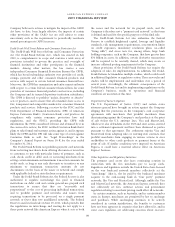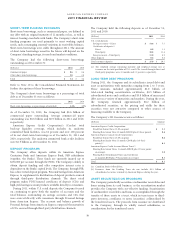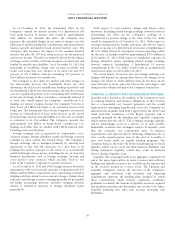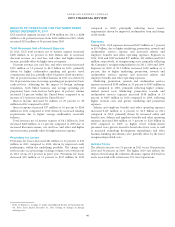American Express 2011 Annual Report Download - page 38
Download and view the complete annual report
Please find page 38 of the 2011 American Express annual report below. You can navigate through the pages in the report by either clicking on the pages listed below, or by using the keyword search tool below to find specific information within the annual report.AMERICAN EXPRESS COMPANY
2011 FINANCIAL REVIEW
INSTITUTIONAL CREDIT RISK
Institutional credit risk arises principally within the Company’s
Global Corporate Payments, Global Merchant Services, and
Global Network Services, Prepaid Services, Foreign Exchange
Services (formerly known as Global Foreign Exchange Services)
businesses and investment and liquidity management activities.
Unlike individual credit risk, institutional credit risk is
characterized by a lower loss frequency but higher severity. It is
affected both by general economic conditions and by client-
specific events. The absence of large losses in any given year or
over several years is not necessarily representative of the level of
risk of institutional portfolios, given the infrequency of loss
events in such portfolios.
Similar to Individual Credit Risk, business units taking
institutional credit risks are supported by Chief Credit Officers.
These officers are guided by the Institutional Risk Management
Committee (IRMC), which is responsible for implementation
and enforcement of the Institutional Credit Risk Management
Policy and for providing guidance to the credit officers of each
business unit with substantial institutional credit risk exposures.
The committee, along with business unit Chief Credit Officers,
makes investment decisions in core risk capabilities, ensures
proper implementation of the underwriting standards and
contractual rights of risk mitigation, monitors risk exposures,
and determines risk mitigation actions. The IRMC formally
reviews large institutional exposures to ensure compliance with
ERMC guidelines and procedures and escalates them to the
ERMC as appropriate. At the same time, the IRMC provides
guidance to business unit risk teams to optimize risk-adjusted
returns on capital. A company-wide risk rating unit and a
specialized airline risk group provide risk assessment of
institutional obligors.
Exposure to Airline Industry
The Company has multiple important co-brand, rewards and
corporate payments arrangements with airlines. The Company’s
largest airline partner is Delta Air Lines and this relationship
includes exclusive co-brand credit card partnerships and other
arrangements including Membership Rewards, merchant
acceptance, travel and corporate payments. Refer to Note 22 to
the Consolidated Financial Statements for further discussion of
these relationships.
European Debt Exposure
As part of its ongoing risk management process, the Company
monitors its financial exposure to both sovereign and
non-sovereign customers and counterparties, and measures and
manages concentrations of risk by geographic regions, as well as
by economic sectors and industries. Several European countries
have been subject to credit deterioration due to weaknesses in
their economic and fiscal situations. The Company is closely
monitoring its exposures to Italy, Spain, Ireland, Greece and
Portugal, which have been determined to be high risk based on
the market assessment of the riskiness of their sovereign debt and
the Company’s assessment of their economic and financial
outlook. As of December 31, 2011, the Company did not hold
any investments in sovereign debt securities issued by Italy,
Spain, Ireland, Greece or Portugal, and the Company’s gross
credit exposures to government entities, financial institutions
and corporations in those countries were individually and
collectively not material.
MARKET RISK MANAGEMENT PROCESS
Market risk is the risk to earnings or value resulting from
movements in market prices. The Company’s market risk
exposure is primarily generated by:
폷Interest rate risk in its card, insurance and Travelers Cheque
businesses, as well as in its investment portfolios; and
폷Foreign exchange risk in its operations outside the United
States.
Market Risk limits and escalation triggers within the Market
Risk and Asset Liability Management Policies are approved by
the Audit and Risk Committee and ALCO. Market risk is
centrally monitored for compliance with policy and limits by the
Market Risk Committee, which reports into the ALCO and is
chaired by the Chief Market Risk Officer. Market risk
management is also guided by policies covering the use of
derivative financial instruments, funding and liquidity and
investments.
The Company’s market exposures are in large part
by-products of the delivery of its products and services. Interest
rate risk arises through the funding of cardmember receivables
and fixed-rate loans with variable-rate borrowings as well as
through the risk to net interest margin from changes in the
relationship between benchmark rates such as Prime and LIBOR.
Interest rate exposure within the Company’s charge card and
fixed-rate lending products is managed by varying the
proportion of total funding provided by variable-rate debt and
deposits compared to fixed-rate debt and deposits. In addition,
interest rate swaps are used from time to time to effectively
convert fixed-rate debt to variable-rate or to convert variable-
rate debt to fixed-rate. The Company may change the mix
between variable-rate and fixed-rate funding based on changes in
business volumes and mix, among other factors.
The Company does not engage in derivative financial
instruments for trading purposes. Refer to Note 12 to the
Consolidated Financial Statements for further discussion of the
Company’s derivative financial instruments.
36
























